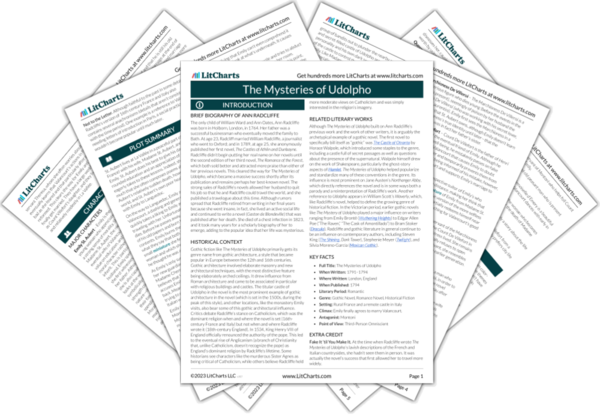Welcome to the LitCharts study guide on Ann Radcliffe's The Mysteries of Udolpho. Created by the original team behind SparkNotes, LitCharts are the world's best literature guides.
The Mysteries of Udolpho: Introduction
The Mysteries of Udolpho: Plot Summary
The Mysteries of Udolpho: Detailed Summary & Analysis
The Mysteries of Udolpho: Themes
The Mysteries of Udolpho: Quotes
The Mysteries of Udolpho: Characters
The Mysteries of Udolpho: Symbols
The Mysteries of Udolpho: Theme Wheel
Brief Biography of Ann Radcliffe

Historical Context of The Mysteries of Udolpho
Other Books Related to The Mysteries of Udolpho
- Full Title: The Mysteries of Udolpho
- When Written: 1791–1794
- Where Written: London, England
- When Published: 1794
- Literary Period: Romantic
- Genre: Gothic Novel, Romance Novel, Historical Fiction
- Setting: Rural France and a remote castle in Italy
- Climax: Emily finally agrees to marry Valancourt.
- Antagonist: Montoni
- Point of View: Third-Person Omniscient
Extra Credit for The Mysteries of Udolpho
Fake It ‘til You Make It. At the time when Radcliffe wrote The Mysteries of Udolpho’s lavish descriptions of the French and Italian countrysides, she hadn’t seen them in person. It was actually the novel’s success that first allowed her to travel more widely.
Not to the Letter. Although faithful to the past in some details, Radcliffe’s version of 16th-century France and Italy also contains several anachronisms (details that aren’t consistent with the time period). One example is a reference to Valancourt needing letters of introduction in Paris, a social practice that wouldn’t become popular until much later.







